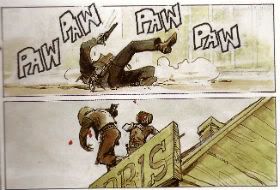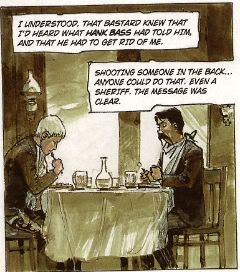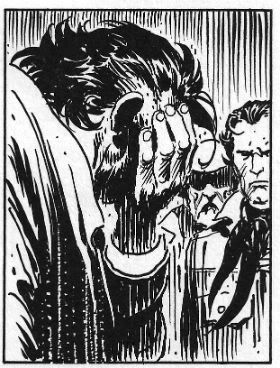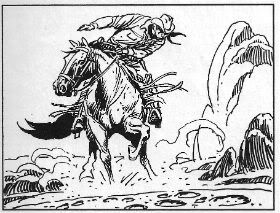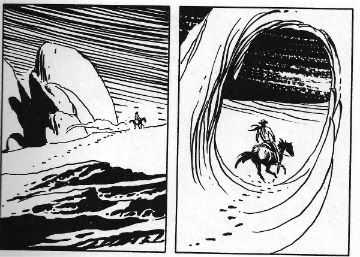"Okay, Let's Go." Comics! Sometimes They Contain Cowboys!
/I hear tell there's no call for Western comics no more. I reckon folks don't know diddly squat. One's I read made me more than partial to 'em.
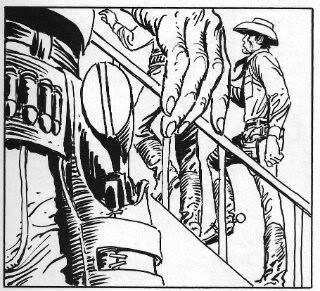
Hunker down a spell why doncha and hear me jaw about a couple of Western comics. WESTERN By Grzegorz Rosiński (a) and Jean Van Hamme (w) Cinebook, 2011, $15.95/£7.99
In the year 1868 Ambrosius Van Deer’s reunion with his long lost nephew goes badly wrong. Blood is spilled, secrets are revealed and Destiny sets a course for tragedy that will be years in the shaping.
WESTERN is a tale of love, revenge, identity and destiny that spans the period of 1868-1922 over its 64 pages of densely packed story. It is the product of the w/a team behind the Belgian comic series THORGAL which is a series I have not read but is apparently one of the most popular French language comics there is. Look, I can’t read everything and since I am mono-lingual (if that) I’ll just have to take Wikipedia’s word. Also, if WESTERN is any indication then the popularity of THORGAL is understandable; for this is a very good comic indeed.
To my uneducated eyes European comics seem primarily artist driven (Rosinski is credited first on the book cover) as opposed to the current state of American affairs where the writer is king (or if not king then architect). Certainly this book is noteworthy primarily for the art. As is no doubt obvious this book is my first exposure to Rosinski’s work but I have to say that Rosinski work is pretty stellar. Characters are easily identifiable, settings are convincing, staging is clear, actions are active and all these things are to be applauded rather than taken for granted. Rosinski knows what he is doing and he does it very well indeed. Over the top of all this understated excellence Rosinski applies a lovely faded wash of colour, sometimes even dropping lines out entirely leaving only the soft hues to carry the image. Rosinski is obviously talented with colour and that’s most in evidence in the full-colour paintings that punctuate the episodic narrative. These are things of greatness. If I could scan one in I would but I can’t so take my word if you do pick the book up it’s worth the cover price for these evocative and enduring images alone.
Of course if you do buy it you’ll probably read it so it’s fortunate that Van Hamme doesn't let the side down on writing duties. Given the chronological scope, episodic nature and the limited page count Van Hamme has it all on to keep his narrative successful. Wisely Van Hamme maximises the information provided to the reader by tripling up on the dialogue (effective but blunt as is common with translations) and visual information (gorgeous and invaluable) with the third device of narration. Clearly at home with words beyond dialogue (it’s called writing) Van Hamme doesn't use his narrative voice to merely utilitarian ends. In fact Van Hamme bookends the tale with two nice pieces of misdirection. The first is clever but the second and final occasion is cleverer as it defies expectations in a way which is truly surprising and emotionally affecting. That’s real writing and, yes, it is hard. The actual story doesn't lack for incident, excitement or drama provided you can stand a healthy dose of coincidence and the accept the fact that a one-armed man can be such a crack shot. But coincidence is ever melodrama’s companion and a Western without a crack-shot protagonist would be a very short comic indeed. The melodramatic momentum together with the eventful occurrences keep the thing moving towards its fateful end quite smoothly and the artful efficiency of the storytelling combined with the sepia washed beauty of the art results in WESTERN being VERY GOOD!
TEX: The Lonesome Rider By Joe Kubert (a) and Claudio Nizzi (w) SAF Comics, 2005, $15.95/£9.50
Tex visits some old friends only to find them slaughtered by a gang of “rascals”. Saddling up and heading out Tex vows to bring them to justice Texas Marshal style!
TEX: The Lonesome Rider is an attempt to introduce the long running (since 1948!) Italian comics series to the nation in which it is set; that’s you, America. To do so they chose the immaculate Joe Kubert to do the art chores. This process together with the history of Tex is detailed in introductory front matter in the volume. The best part of this is an interview with Joe Kubert in which he gives new dimensions to the word “concise”. A man of few words our Joe Kubert is, prefers to speak with his brush, I guess. A bit like old timey cowboy heroes who were tight lipped and let action speak louder than words. (Yes, my segues do require more work, thanks for noticing). And TEX is certainly nothing if not old-timey.
While WESTERN is clearly, and convincingly, set in a realistic approximation of the Old West the action in TEX is set in a kind of shared popular memory of the West. It’s a world of white hats and black hats (literally), bad men, good men and weak men that find the strength to be good, the hidden nobility of the savage, saloon brawls and stage coach hijacks. Rather than some clever post modern device I’d imagine this is merely the result of basing a series on popular culture and the changeover from Tex’s “papa” Giovanni Luigi Bonelli to other hands. It’s probable that since TEX worked there seemed little reason to change it so the revisionism of the Western since The Searchers (maybe? The Wild Bunch? you choose.) has had little impact on this book. Which isn't to say it is bad but is to warn you that it is all quite familiar and not terribly concerned with realism. It’s a yarn really and it does what yarns are supposed to do; it entertains. Actually it does more than entertain it delights but it only delights because of the presence of Joe Kubert.
Joe Kubert. There’s a name to conjure with and with TEX that name conjures up 240 pages of Black & White magic. Seriously, 240 B&W pages of Joe Kubert art and you aren't already haranguing your LCS to get you a copy? I have to say more? Okay then. Joe Kubert’s work on these pages elevates the whole thing not just one level, but maybe two or three. Which is fortunate as the dialogue is bland (it’s translated) and the plot is solid but perfunctory. There are just so many Joe Kubert joys on these pages it’s almost indecent.
The big thing about Joe Kubert is he’s a pen and ink prestidigitator par excellence. He fools your eye into thinking you are witnessing perfection; into thinking that line is in the only place it could be. Whereas a Toth would fuss and worry over actually finding the right line Joe Kubert can approximate that line with such confidence that he doesn't have to actually find that line. That’s not a back handed compliment there’s more art and skill in such suggestion than I can verbalise. He does practically nothing with the landscapes in this book but he does everything needed to make them practically a character unto themselves. The best panels in this book are the panels where Joe Kubert’s art is free of words and there are many such panels in this book. Comics may be a marriage of words and images but the greatest artists can make those images speak with words finer than the finest writer. Joe Kubert is one such artist and his presence makes TEX VERY GOOD!
Both these books are worth your eye-time, both these books are Westerns I’d suggest you don’t let the latter blind you to the former. But that’s just me. And me? I’m gone like the American West.


